For SEA Italian Quality Tanks, the unceasing innovation of its processes represents an irremissible element to meet the various market requirements in more and more competitive way. A precise orientation that this year has concretely resulted in the start up of a new robotic manufacturing isle. KEY factor, for the achievement of the expected operational and flexibility requisites, is the in-line press made by F.lli Nava, manufacturer that once more stands out as reference supplier and qualified technical partner.
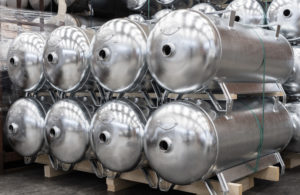
They have a capacity that ranges from 5 to 500 litres, an operation pressure between 8 and 21 bars and they find application in various sectors among which stand out, besides the varied industrial world, automotive, the agricultural and medical sectors, too. The products at stake are the compressed air tanks designed and manufactured by SEA Italian Quality Tanks, company that in almost 70 years of activity has succeeded in matching craft tradition and technological innovation, to suit the requirements of a more and more dynamic and global market. Made-in-Italy production, customized upon precise technical specifications, where process automation and efficiency allow satisfying customers’ demands all over the world in short times and with the most rigorous qualitative standard.
«The growth strategy and vision ideated by our father – explains Fabrizio Cattaneo, third managing generation with his brother Federico and his father Giorgio – since the Nineties has always consisted in best exploitation of technology, to replace progressively manual repetitive activities and entrusting human resources with higher added-value tasks».
Automated-control production isles are in fact the core of SEA system, solutions with high technological content in constant upgrading and evolution. Like in the case of the recent integration of a new isle for the bottom forming and tank coupling welding. A fully automated plant, consisting of sheet metal decoiler, forming press, with annexed robotic flanging and welding, developed with the precise target of decreasing the cycle time, increasing quality (through more precise NC regulations) and minimizing retooling times.
«A third bottom forming line–Cattaneo underlines – that not only improves our manufacturing capacity but, especially, significantly enhances our operational flexibility».
Key element of this production isle is also the 160-ton press supplied by F.lli Nava, which confirms its role as reference supplier and ideal technical partner for applications with high quality and performance content.
«A press –Cattaneo specifies– that joins the other two, featuring 160 and 400 tons, working for a long time in the other two bottom forming lines equipping the factory».
Utmost levels of flexibility and productivity
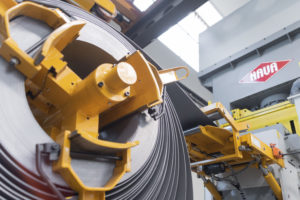
With maximum ram force of 1,600 kN, 800 kN lower blank holder and work surfaces with 1,200 x 1,000 mm sizes, the new press bought by SEA is conceived as solution to the special forming requirements for tank bottoms intended for the industrial sector of compressors. An execution that addresses a high-end market segment, where the press quality becomes a decisive competitiveness element, permitting to implement objects with constantly tested quality and high performances.
«Products –Cattaneo highlights– manufactured in more fragmented batches than in the past but anyway called to satisfy high quality specifications and all requisites imposed by severe international regulations: about 70% of our production is in fact exported beyond the borders, not only in the European market but also in the American, Middle-East and Asian one».
More in detail, the press is provided with a ram with maximum adjustable force and driven with high guide ratio. This solution, typical of F.lli Nava’s design philosophy, assures the best result in case of eccentric stresses that can emerge in the die owing to the asymmetries of the components to be obtained or in case of not completely symmetric behaviour of the material under forming. The machine is then equipped with blank holder cushion with reaction force that can be adjusted in highly flexible manner during the entire cycle execution. This allows fully meeting the needs of holding, or letting the sheet metal slide, according to the forming progress. Only in this way it is possible to benefit concretely from all those devices designed and implemented in the die to avoid excessive workpiece thinning that would result in rejects and unsatisfactory quality of formed parts. The reaction cylinder is electronically managed to assure the wished pressure profile according to the drawing stroke.
Spotlights on forming
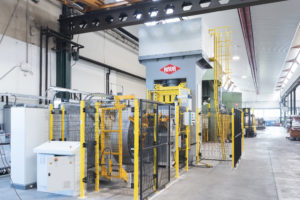
From the point of view of the man-machine interface, further efforts have been made by F.lli Nava to achieve increasingly operator-oriented diagnostics, to allow identifying in a glance eventual failure causes (like for instance inconsistent settings of work parameters or incorrect machine preparation to start the forming cycle).
«Fundamental peculiarity, the latter –Cattaneo points out – to keep the process under control and to withstand at best the pressing production rhythms and the more and more frequent changeovers».
More in general, to facilitate the task of die set up and the regulation of the optimal selectable parameters to produce the desired item, the press control can be implemented with the addition of graphic pages that illustrate the process value trends in their evolution while pressing. Due to this simple but powerful process tracing function, it is possible to control, step by step, the evolution of the forming procedure in its accomplishment, especially in the salient phases that take place with closed die and then more hardly followed from the outside. On the other hand, this base function can be extended, permitting the filing and the printing of the dynamic process image: with the advanced version of cycle tracing historicizing, you can make use of the achieved graph, both video and on paper, to ponder the expected evolution comparing it with the real one obtained and with the outcome on the material piece. This function, in particular, represents a valid support for those who may need to document the adopted machining parameters and the evolution of the machining cycle accomplished to implement their production comparing, in time, such parameters with those registered as benchmark with which the die testing has been carried out.
From process quality to product quality, certified
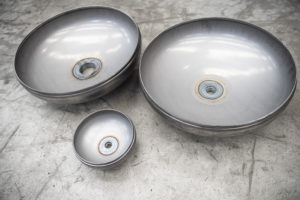
The functions of process data management provided by F.lli Nava’s press perfectly match SEA’s needs of integrating the new robotic isle with the company’s in-house managerial system.
«For years now –Cattaneo confirms– we have implemented MRP software for the production management that reprocesses and develops job orders’ workflows. This means that each division daily receives all machining information concerning the production of caps, ferrules and related components according to order priorities».
A strong point that permits the entire process optimization, dealing with the strong product customization that today corresponds to over 80% of the overall production.
From technical design to engineering and prototyping, SEA has made process automation one of its distinguishing traits to assure the highest competitiveness levels. Production where robotics (entrusted with automation, welding and handling) is perfectly integrated with logistics and product finishing activities.
«The optimized management of our processes – Cattaneo ends – and the broad warehouse of finished and semi-finished products allow us to assure very fast delivery terms and to shorten customers’ provisioning times».
The company in short
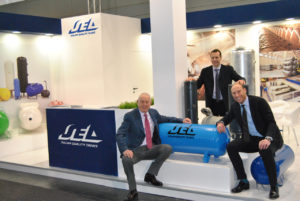
SEA SpA stems in 1950 from the work and passion of Giorgio Cattaneo, who was able to transform the original mechanical workshop into a dynamic company that designs, manufactures and markets compressed air tanks. Agrate Brianza (MB) headquarters, in the outskirts of Milan, today cover an area of over 12,000 square metres and are organized in production divisions and isles of high technological level. Robotic forming and welding plants that allow satisfying, in very short times and with the most rigorous quality standard, customers’ demands worldwide. The company in-house manufactures each tank, starting from coils and carbon steel sheets, with automated welding processes of ferrules, bottoms and related components (brackets, feet, bases, couplings and so on). An average production of over 12,000 tanks monthly, manufactured with an efficient optimized operational course and the support of about fifty employees. More than 15% of the turnover is invested every year in new high-tech machines: a winning strategy, awarded with a steeply rising 2018-turnover, in both volumes and values, versus the previous year.



